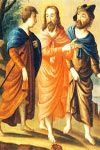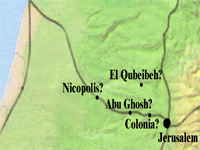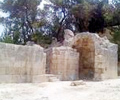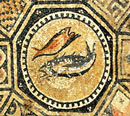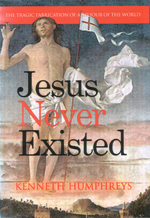A meeting with strangers?
Oddly, for one of his first post-death appearances, JC materializes to two unknown characters, Cleopas and the "other one".
Great witnesses, don't you think?
Where is Emmaus?
Christians have never agreed which site should be honoured with the divine visitation. Luke's only clue is "about sixty stadia" from Jerusalem.
English Bibles often use the archaic unit of distance the "furlong" as an equivalent of the Greek "stadion" used in Luke.
Roughly equivalent to about one-eighth of a mile, the stadion derives from the length of the original running track at Olympia, whereas the furlong originates from the long length or furrow of the medieval field system,
Luke's 60 furlongs is thus about seven and a half miles but he does not say in which direction.
Nicopolis ("Emmaus")
Byzantine ruins of Nicopolis were excavated in the 1920s.
Josephus on Emmaus
Luke's regular source for "detail", the Jewish historian Josephus, has quite a lot to say about Emmaus, because three places are so named. But not one of them quite fits Luke's little drama.
The most important Emmaus was a major town in Judaea which was "reduced into slavery" by Cassius, Caesar's assassin, for failing to pay its taxes (Ant. 14.11). The same town was burnt by Varus following riots after the death of Herod (Ant.17.10).
It was this "provincial capital" that became a legionary base in the first Jewish war and was subsequently renamed Nicopolis in 70 AD.
An image of Nicopolis is preserved in the Madaba map, a 6/7th century mosaic of the Byzantine world which graces the floor of a 19th century Jordanian church. Originally a massive 94 square meters, about one quarter remains.
The other two Emmaus described by Josephus were much smaller than Nicopolis. One was a settlement of Roman veterans (see main text), the other a spa close by Tiberias in Galilee. Josephus interprets the name Emmaus thus:
"Emmaus, if it be interpreted, may be rendered "a warm bath," for therein is a spring of warm water, useful for healing," – Wars 4.1.3.
* "Cleopas" inspired by Buddhist scripture?
Buddhist scripture may explain Luke's use of the name Cleopas.
A disciple of the Buddha was Kas'ya'pas who was travelling with 500 monks when he encountered an unknown personage.
From this unknown figure Kas'ya'pas learnt of the death of the Buddha.
Was that 60 or 160 stadia?
One of 51 leaves from Papyrus Bodmer P75. (c. 175-225) which records that Emmaus was sixty stadia from Jerusalem.
That fishy story
The Luke-John fisherman's tale has its beginnings in lore told about Pythagoras.
The number 153 is a sacred or "triangular" number in the Pythagorean system. Archimedes, for example, in his book Measurement of a Circle, uses the whole number ratio 153:265 to express the square root of 3.
The Pythagoreans, centuries before the Christians, dressed up their wisdom in homey tales about their own guru. A work by Neoplatonist Iamblichus Chalcidensis, records an incident said to be from the life of Pythagoras which anticipates the gospel fishy yarn in all respects.
In particular, it helps to explain that curious catch of precisely 153 fishes of John 21.11.
"Pisces" in an early Christian mosaic (Megiddo, 3rd/4th century).
Iamblichus
Life of Pythagoras, 8."At that time also, when he was journeying from Sybaris to Crotona, he met near the shore with some fishermen, who were then drawing their nets heavily laden with fishes from the deep, and told them he knew the exact number of the fish they had caught.
But the fishermen promising that they would perform whatever he should order them to do, if the event corresponded with his prediction, he ordered them, after they had numbered the fish, to return them alive to the sea; and what is yet more wonderful, not one of the fish died while he stood on the shore, though they had been detained from the water a considerable time.
Having therefore paid the fishermen the price of their fish, he departed for Crotona. But they everywhere divulged the fact, and having learnt his name from some children, they told it to all men."
"This story has simply attached itself to Jesus as it floated around the religious world of the Mediterranean."
– Price, The Incredible Shrinking Son of Man, p158).
Iamblichus died during the reign of Constantine (c 325) and the Christians burned his books.
"And their words seemed to them as idle tales, and they believed them not." – Luke 24.11.
Of the dozen or so post-death appearances claimed for Jesus Christ, the "most detailed" (a whole 20 verses) is the one reported solely by Luke, "on the road to Emmaus." Alarmingly, from the perspective of historical proof, the two primary witnesses for the "risen Christ" in this incident are unknown – one named but nowhere else mentioned, the other not even named. Adding further to the suspicion that what we are dealing with is not history but pious fabrication is a curious uncertainty surrounding the supposed location. Faith, we are told, rests upon the historical testimony of those who "saw and bore witness". But what if that testimony is itself merely a fiction inspired by faith? Of such fluff is the central drama, the cardinal belief of Christianity made.
Rise and Shine – "The best attested event in history" The Emmaus appearance of the "risen Christ" is unique to Luke. At the point where the other gospels have more to say about "the women", the author of Luke introduces new characters. The "risen Christ" appears to two disciples, walks and talks with them, joins them for dinner and yet throughout remains unrecognised. JC remains unrecognised even at close quarters. Only in an instant, when he breaks bread and disappears, do the two disciples realise it was the Lord. Is this history? The tale begins after the women have made an astonishing report that the body is missing and an angel has said the "Son of Man" is alive. They are not believed. Unlike in Mark, Mary Magdalen does NOT report an early morning encounter with JC. Thus Luke is about to reveal the "first" and most detailed appearance of the risen Christ:
A familiar source Luke's "authentic detail" of naming the village to which the two walked raises an obvious question, Where was Emmaus? Although no fewer than nine sites have been proposed for the village, nothing in archaeology or literature confirms any particular location. Only one other ancient writer besides Luke refers to the "village" of Emmaus – Josephus (surprise, surprise!). In War 7.6 Josephus writes:
It should be noted that the classic 18th century Whiston translation of Josephus is here used. The Penguin edition of G. Williamson substitutes a "correct" three and a half miles. The Zondervan, Grand Rapids, edition of Gaalya Cornfields tidies things up further with "thirty furlongs".
Reality check The site near Jerusalem where Vespasian settled his eight hundred veterans was named by the Romans (quite logically) Colonia. But it seems this small community faded away in the 2nd century with the development of "victory city" – Nicopolis – a few miles further up the road to Joppa. For two years prior to the war Nicopolis had been the base of the 5th Legion and over the next century it developed all the normal features of a Roman town. Colonia may have been a casualty of the second war of the Jews led by Bar Kosiba (130-135) when many small settlements were destroyed. Certainly, with its "Roman" population, Colonia held no place in Christian folklore. When, in the 4th century, Constantine's mother Helena started a scramble to sanctify Jesus venues all across the "Holy Land", it was not Colonia but Nicopolis which was chosen to be Emmaus and was renamed accordingly. To preserve inerrancy, copyists arbitrarily changed Luke's 60 stadia (as found in the oldest manuscripts – P75, Codex Alexandrinus, Codex Vaticanus, etc.) to 160 stadia. Unfortunately at a distance of 19.3 miles this change made a nonsense of Luke's yarn of the two disciples walking back to Jerusalem (uphill and after dark!) and finding the other disciples still awake. Adding to the fun, copies of Luke that followed the "old Latin" Codex Palatinus (a silver on purple creation of 5th century Italy) had the evangelist place Emmaus at a distance of seven stadia!
Unknown witness Luke names just one of the two walkers, Cleopas (Cleophas) a disciple found nowhere else in the Bible* but perhaps a variant on Clopas (husband of the "other Mary"), and puts into his mouth words which in a curious way anticipate the so-called Testimonium Flavianum later added into the work of Josephus.
The journey and the day progress yet remarkably the two disciples remain clueless as to the identity of the sagacious stranger. When JC performs his vanishing trick over dinner it is not his disappearance that elicits comment (!) but instead his endorsement of the scriptures!
A mobile legend With the passing centuries, the legend of Emmaus not only grew – it moved house! In the early Byzantine period, the scheming Eusebius of Caesarea championed the claims of Nicopolis, a town that happened to be within his own diocese. Seriously peeved that Jerusalem had proclaimed so many lucrative "holy places", the bishop was only too happy to affirm that the one disciple named in the incident (Cleopas) had actually lived in the town. A shrine was born. Jerome, who moved into the area when exiled from Italy, contributed the embellishment that JC had indeed consecrated the Cleopas house as a church! (Letters, 108.8). Salminius Sozomen, a fifth century Christian historian, vouched for a "miraculous water source" at Nicopolis where JC had washed his feet (and of course pilgrims could procure a healing!). Even into the Islamic period, the visiting Willibald of Eichstaett in 723 had been certain that the disused church of Nicopolis stood on the ruins of Cleopas' house. But religion is ever the hand-maiden of profane ambition. When "Latin" knights arrived from western Christendom in the 12th century, the crusaders neither knew nor cared for the Greek "traditions". Using their own unedited Luke, they measured off 60 stadia from the walls of Jerusalem and selected Abu Ghosh as the true "Emmaus". As it happened, at this location in the 2nd century the 10th Legion had built a reservoir which 9th century Arabs had modified into a caravanserai – visible proof for the pious Christian warriors that this had been the very spot that the Risen Lord had "broken bread"! After two centuries, following the battle of Hattin (1187), the western invaders were expelled and the fabled "Emmaus" entered another hiatus. Franciscan monks (would-be custodians of the "Holy Land" as a result of papal Bulls) re-entered the area in the 16th century and again measured off 60 stadia but this time round on a different road. Now it was the turn of El Qubeibeh to play the role of "Emmaus". And wouldn't you just know it – an ancient wall was identified as part of the house of Cleopas and a church built around it! Father Bellarmino Bagatti conducted encouraging investigations at this "Emmaus" during the 1940s – and of course he was the excavator of the no less phantasmic "1st century Nazareth"!
Off to tell the others In the second part of Luke's Emmaus fantasy, the "two" rush back to Jerusalem (whatever the time or distance) to tell the good news to the rest of the gang, who apparently had "fled" but evidently are all together. Curiously, it is the "eleven gathered together" who speak first, telling the two who have dashed back from Emmaus that "The Lord has appeared to Simon".
The yarn is as elegant as a one-legged cow. Only after the Simon revelation do the two roadies tell their own "breaking bread" story.
There is every evidence here of a story continuously re-written to cram in additional "good ideas". Mark's own sacerdotal point – in the single verse "dinner with the unbelieving eleven" (Mark 16.14) – had been "believe others who have seen". Luke has a new didactic point to make, clarifying the nature of what is seen. Luke's target is a certain type of Christian who follows a "Pauline" doctrine of a spiritual saviour. Luke has the godman himself answer the "questionings of the troubled" by demonstrating that the risen Christ is no mere "spirit" but flesh and blood. Luke's Christ, let's be clear, has real hands and feet and eats fish.
Last goodbyes Luke's "risen Christ" finally delivers a liturgical commission to his disciples to evangelise "among all the nations", leads the merry men out to Bethany (near Jerusalem) and before their very eyes is carried up to heaven. The "ascension" here (and in Mark) occurs the same day. But Luke quite forgets himself when he writes the sequel in Acts, for here we're told JC "shewed himself alive after his passion by many infallible proofs, being seen of them forty days"! (Acts 1.3). And in Matthew the story is not at all like this. The "eleven" follow the instructions delivered by the two Marys from a stone-moving angel (AND from the "risen Lord" himself, just to make sure – you can't rely on those women!) to gather on a mountain in Galilee. In this re-make of "Moses, delivering the commandments from a mountainside", JC delivers his commission to "teach all the nations", promises to be with them always – and the story ends limply (Matthew 28.16,20). Even the living and speaking presence of a resurrected Jesus leaves some of them "doubting" – what hope is there for the rest of us! The point, no doubt, is to mock the skeptical, for whom no evidence will be good enough. John's offering is different again, rehashing the pre-crucifixion fishy story from Luke into a post-mortem fishy story set 75 miles away from Jerusalem on the Sea of Galilee (Gennesaret / Sea of Tiberias).
Here we have plagiarism that is also counterfeit – chapter 21 is a so-called "appendix" to John which in its earlier editions ended with the concluding words of 20.30! John also describes the Galilean appearance as the "third" (21.14) when in fact John has already detailed three other appearances, the first to Mary Magdalen (20.4), the second to the disciples sans Thomas (20.19), the third eight days later to the disciples with Thomas (20.26). Clearly the appearance to Mary didn't really count!
Theology creates its own "evidence"
Believe but don't expect to physically see the resurrected Christ (that privilege has passed!). Remember, the risen Lord will be ever-present at the breaking of bread, the eucharist, now instituted as a "thanksgiving" sacrament of the church. Reject the esoteric "spiritual rebirth" of the Gnostics, our Lord promises a genuine rebirth in a touchy-feely body. Be assured, only the "hard hearted" refuse to believe in the "risen Lord" from the evidence of scripture. And that's the only evidence you are going to get!
PS: Source? The Emmaus story is unique to Luke, but it appears in truncated form in the addendum to Mark, chapter 16. Here, there is no suggestion that JC was unrecognized:
But if the Lukan Emmaus story doesn't derive from Mark but merely is summarized therein, the tale has its source somewhere – and probably not the fertile imagination of the author of Luke. The French writer Jean Magne has argued for inspiration in Genesis and a link between Emmaus and Eden, where the two disciples on the road correspond to Adam and Eve of the original garden. In Luke's re-write, Jesus corresponds to the instructive serpent of Genesis – an idea familiarly encountered in Gnostic texts which would have been available to the author of Luke. In both stories, there is a "revelation of knowledge from a former state of ignorance". Whereas Adam and Eve eat the forbidden fruit and recognize their nudity, Luke's disciples eat bread and realize the truth. Richard Carrier has argued that, "the Emmaus narrative in Luke is clearly a transvaluation of the legend of Romulus and Proculus." Well, why waste a good yarn?
Sources:
'Save' a friend e-mail this page
Copyright © 2007
by Kenneth Humphreys.
|
||||||||||||||||||||||||||||||||||||||||||
